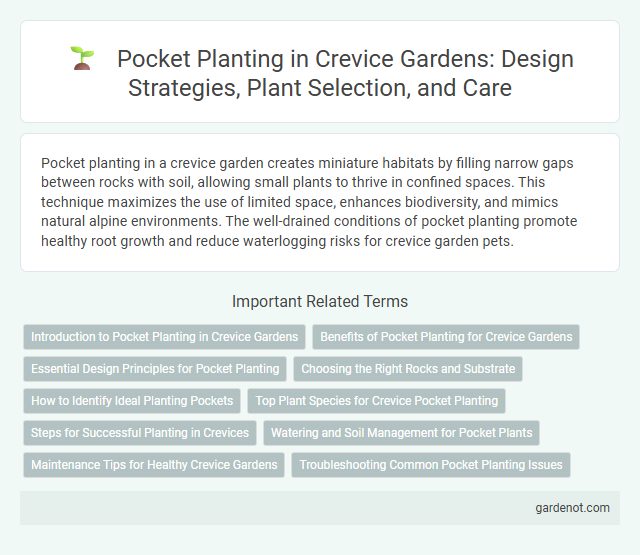Pocket planting in a crevice garden creates miniature habitats by filling narrow gaps between rocks with soil, allowing small plants to thrive in confined spaces. This technique maximizes the use of limited space, enhances biodiversity, and mimics natural alpine environments. The well-drained conditions of pocket planting promote healthy root growth and reduce waterlogging risks for crevice garden pets.
Introduction to Pocket Planting in Crevice Gardens
Pocket planting in crevice gardens maximizes the use of narrow, shallow soil spaces between stones, creating microhabitats ideal for drought-tolerant alpine and rock garden plants. This technique supports diverse flora like saxifrages, sedums, and sempervivums by providing optimal drainage and protection from harsh conditions. Integrating pocket planting enhances the naturalistic appeal and ecological resilience of crevice gardens.
Benefits of Pocket Planting for Crevice Gardens
Pocket planting enhances crevice gardens by maximizing limited space, creating microhabitats that support diverse plant species adapted to rocky environments. This technique improves soil moisture retention and reduces erosion by filling crevices with nutrient-rich substrate, promoting healthier plant growth. The strategic placement of plants in pockets also increases biodiversity and visual interest, making the garden more resilient and aesthetically appealing.
Essential Design Principles for Pocket Planting
Pocket planting in crevice gardens maximizes limited space by strategically placing plants in narrow gaps between rocks, emphasizing species suited for harsh, dry conditions with shallow root systems. Essential design principles include selecting drought-tolerant, low-maintenance plants like succulents and alpine species, arranging them based on microclimate variations, and ensuring proper drainage to prevent waterlogging. Incorporating textural and color contrasts enhances visual interest while maintaining ecological balance within these compact, rocky microhabitats.
Choosing the Right Rocks and Substrate
Selecting the right rocks for a crevice garden involves choosing durable, weather-resistant stones such as granite, sandstone, or limestone that create natural pockets for planting. The substrate should be a well-draining mix of gritty sand, organic matter, and small gravel to support root growth while preventing water retention. Proper rock and soil selection ensures optimal drainage and root aeration, essential for thriving pocket plant conditions.
How to Identify Ideal Planting Pockets
Ideal planting pockets in a crevice garden are characterized by crevices that maintain consistent moisture without waterlogging, offering well-draining soil rich in organic matter. These pockets are typically located where the rock formation provides natural protection from harsh winds and direct sun exposure, creating a microclimate suitable for pocket plants. Identifying pockets with sufficient depth and width to accommodate root systems ensures healthy growth and long-term plant stability in the crevice garden.
Top Plant Species for Crevice Pocket Planting
Top plant species for crevice pocket planting include drought-tolerant succulents like Sedum, Sempervivum, and Delosperma, known for their ability to thrive in shallow, rocky substrates. Hardy alpine plants such as Saxifraga and Dianthus also excel in crevice environments due to their compact growth and resilience to temperature fluctuations. These species optimize water retention and root anchorage, making them ideal for sustainable crevice gardens.
Steps for Successful Planting in Crevices
Carefully clean and widen crevices to create ideal pockets for planting, ensuring sufficient space for root growth and water retention. Select drought-tolerant, shallow-rooted plants such as succulents, alpine species, or mosses that thrive in minimal soil conditions. Gently insert plants into the pockets, secure them with a small amount of soil or gravel, and maintain consistent moisture while acclimating the plants to their environment.
Watering and Soil Management for Pocket Plants
Pocket planting demands precise watering techniques that prevent waterlogging while ensuring consistent moisture to support plant health in confined spaces. Utilizing well-draining, nutrient-rich soil mixtures enriched with organic matter enhances root aeration and sustains moisture retention, critical for pocket plants' growth. Implementing mulch layers reduces evaporation rates and stabilizes soil temperatures, optimizing water use efficiency in crevice garden pockets.
Maintenance Tips for Healthy Crevice Gardens
Pocket planting in crevice gardens requires targeted watering and careful soil management to prevent erosion within narrow gaps. Regular inspection for debris buildup and prompt removal of dead foliage help maintain airflow and reduce pest infestation. Using drought-tolerant, slow-growing alpine species minimizes maintenance frequency while enhancing the garden's resilience.
Troubleshooting Common Pocket Planting Issues
Pocket planting challenges often involve poor drainage, root crowding, and inconsistent sunlight exposure. To resolve drainage issues, amend soil with organic matter to enhance aeration and prevent waterlogging. Ensure adequate spacing to avoid root competition and position plants according to their light requirements to promote healthy growth in crevice gardens.
Pocket planting Infographic

 gardenot.com
gardenot.com